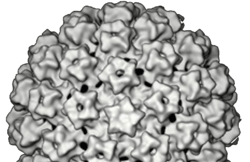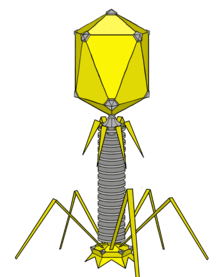DNA viruses have only the deoxyribonucleic acid (DNA) molecules as their nucleic acid; and the DNA can either be double-stranded or single-stranded as the case may be. The replication site of all DNA viruses is the nucleus of their host cell. Nevertheless, Poxviruses (which are also DNA viruses) replicate outside the nucleus of their host cell. Poxviruses replicate in the cytoplasm of their host cell.
All DNA viruses are double-stranded with the exception of Parvoviruses that are single-stranded. Double stranded DNA (dsDNA) viruses infect man, animals, mycoplasmas, algae, fungi and protozoa. However, viruses in this category rarely infect plants. Some DNA viruses have double stranded DNA genome while others have single stranded DNA (ssDNA) genome; and both category of DNA viruses cause infections in humans (Table 1).
A handful of viruses in this category (inclusive of dsDNA and ssRNA viruses) cause a variety of infections and diseases in man and other vertebrates. The replication of the DNA viruses is usually not as complex as is the case for RNA viruses. During the replication process of most DNA-containing viruses, the genome of the host cell (i.e. the DNA) is stimulated by the viral genome which overpowers it and causes it to drive their own DNA replication.
Some of the viral families that make up the DNA containing viruses and that parasitize humans and other vertebrates include: Parvoviridae, Adenoviridae, Herpesviridae, Poxviridae, Hepadnaviridae, Polyomaviridae, Papillomaviridae, Iridoviridae, and Asfarviridae. These viral families have viruses that contain dsDNA genome.
Those viral families with dsDNA genome that parasitize non-vertebrate hosts such as bacteria, Archaea, algae and mycoplasmas include: Myoviridae (bacteria), Siphoviridae (bacteria), Podoviridae (bacteria), Tectioviridae (bacteria), Corticoviridae (bacteria), Plasmaviridae (mycoplasma), Lipothrixviridae (Archaea), Rudiviridae (Archaea), Fuselloviridae (Archaea), Guttaviridae (Archaea), and Phycodnaviridae (algae). The ssDNA viruses (with their host in parenthesis) include: Microviridae (bacteria), Inoviridae (Mycoplasma and bacteria), Circoviridae (vertebrates), and Densovirinae (invertebrates, mosquitoes and silkworm).
The characteristics of some DNA-containing viruses especially those that are of clinical or medical importance to man is shown in Table 1.
Table 1. DNA viruses that parasitize humans
| Viral family | Representative viruses | Replication site | Genome |
| Poxviridae | Cowpox, smallpox, monkey pox viruses and other poxviruses | Outside the nucleus | dsDNA (plus envelope) |
| Herpesviridae | Herpes simplex viruses (HSV) types 1 and 2, Epstein-Barr virus (EBV), cytomegalovirus (CMV), Varicella-zoster virus (VZV), Kaposi’s sarcoma-associated herpes virus (KSHV) and human herpes viruses 6 and 7 | Nucleus | dsDNA (plus envelope) |
| Adenoviridae | Adenoviruses | Nucleus | dsDNA (no envelope) |
| Papillomaviridae | Papilloma viruses | Nucleus | dsDNA (no envelope) |
| Polyomaviridae | Polyomaviruses | Nucleus | dsDNA (no envelope) |
| Parvoviridae | Human parvovirus B19, Dependovirus, Erythrovirus, Iteravirus, and contravirus | Nucleus | ssDNA (no envelope) |
| Hepadnaviridae | Hepatitis B virus (HBV) | Nucleus | ssDNA (no envelope) |
| dsDNA=double stranded DNA; ssDNA=single stranded DNA |
References
Acheson N.H (2011). Fundamentals of Molecular Virology. Second edition. John Wiley and Sons Limited, West Sussex, United Kingdom.
Alan J. Cann (2005). Principles of Molecular Virology. 4th edition. Elsevier Academic Press, Burlington, MA, USA.
Alberts B, Bray D, Johnson A, Lewis J, Raff M, Roberts K and Walter P (1998). Essential Cell Biology: An Introduction to the Molecular Biology of the Cell. Third edition. Garland Publishing Inc., New York.
Barrett J.T (1998). Microbiology and Immunology Concepts. Philadelphia, PA: Lippincott-Raven Publishers. USA.
Black, J.G. (2008). Microbiology: Principles and Explorations (7th ed.). Hoboken, NJ: J. Wiley & Sons.
Brian W.J Mahy and Mark H.C van Regenmortel (2010). Desk Encyclopedia of Human and Medical Virology. Elsevier Academic Press, San Diego, USA.
Brooks G.F., Butel J.S and Morse S.A (2004). Medical Microbiology, 23rd edition. McGraw Hill Publishers. USA.
Cann A.J (2011). Principles of Molecular Virology. Fifth edition. Academic Press, San Diego, United States.
Carter J and Saunders V (2013). Virology: Principles and Applications. Second edition. Wiley-Blackwell, New Jersey, United States.
Champoux J.J, Neidhardt F.C, Drew W.L and Plorde J.J (2004). Sherris Medical Microbiology: An Introduction to Infectious Diseases. 4th edition. McGraw Hill Companies Inc, USA.
Dimmock N (2015). Introduction to Modern Virology. Seventh edition. Wiley-Blackwell, New Jersey, United States.
Dimmock N.J, Easton A.J and Leppard K.N (2001). Introduction to modern virology. 5th edition. Blackwell Science publishers. Oxford, UK.
Discover more from #1 Microbiology Resource Hub
Subscribe to get the latest posts to your email.



